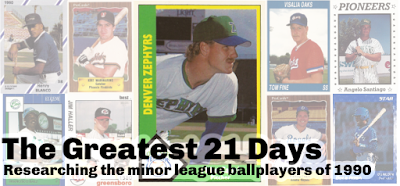 |
| Mahoning Valley coach Phil Clark, left, during a game at Tri-City Aug. 1, 2014. Clark played in five major league seasons. (G21D Photo) |
Part 3: His Character
TROY, NY - Around his sixth season, Phil Clark started wondering if he was actually going to make it.
Taken by the Tigers in the first round of the 1986 draft out of high school, Clark made steady progress through the minors. Until he reached AAA.
He made AAA Toledo for the first time in 1990. He then returned there for 1991, without getting called up to Detroit.
"I wasn't playing everyday," Clark recalled of that time. "I wasn't a first-round pick anymore. That's probably the biggest thing. I wasn't a priority anymore. So that's when that mental process starts to take place."
Clark recalled he even started to think about doing something else in his life.
Then, in 1992, he got his call.
"I got that opportunity and, in my second game, I got two hits," Clark recalled. "And you know, I felt like I belonged. I felt like I could be a part of this."
Clark ended up belonging in five major league seasons. He later more than belonged in four seasons in Japan. In Japan, he became a star.
 |
| Mahoning Valley's Greg Allen waits for a pitch at Bruno Stadium in Troy, NY, in August 2014. Allen's hitting coach is Phil Clark. (G21D Photo) |
Clark covered his career in baseball, from growing up in a baseball family in Texas, to turning pro and working to make the majors.
Once in the majors, Clark worked to stay and become a regular. In one season he was, Clark getting into more than 100 games.
Clark also talked about his time in Japan. In Japan, Clark recalled breaking free from American conventions on hitting. He also broke out for a total of 93 home runs hit over his four seasons there.
Clark grew up in an athletic family in Crockett, Texas. It was a town that only had about 8,000 people in it, "probably less than that now," Clark said.
"It was one of those towns where everybody had to do everything," Clark said. "We all had to play football, we had to play baseball, we had to play basketball, because our school was small."
 |
| From left, Scrappers Francisco Mejia, D'vone McClure, Leo Castillo, Yonathan Mendoza, Ordomar Valdez, and Greg Allen, get ready before an August 2014 game at Tri-City. (G21D Photo) |
Clark's two older brothers, Isaiah Clark and Jerald Clark played the game and they played it well.
Isaiah Clark played well enough at Crockett to be selected in the first round, 18th overall, in the 1984 draft. Clark's oldest brother, Jerald Clark, went to college first. He eventually was taken in the 12th round of the 1986 draft.
With those examples to draw from, Phil Clark set his sights high.
"That was my motivation moving forward when I would come back and get ready for the high school season," Clark said. "My goal was to be a first round pick."
The scouts started coming around, but Clark didn't really notice them. It's not like youth baseball is today, with travel ball. His overall exposure was minimal, he recalled.
 |
| Tri-City Valley Cat Mott Hyde swings in an August 2014 game at Bruno Stadium in Troy, NY. Phil Clark, Mahoning Valley coach, is in the dugout, far right. (G21D Photo) |
"Thinking back on it, you're just trying to do the best you can so anybody would see you," Clark said.
Then he was selected. The Tigers took him in the first round, the round he had hoped for. He was also taken 18th overall, just like his brother Isaiah.
Clark called it awesome to find out he was drafted, along with where in the draft he was taken.
"I don't even think that it hit me," Clark said. "It probably hits me more now than it did back then."
One of the first questions Clark recalled being asked after the draft was supposed to be a simple one. Taken by Detroit, he was asked who his favorite Tiger was. Put on the spot, Clark couldn't name one.
The reason, Clark said, was that he grew up watching the Braves and the National League on TBS. He didn't know much about the Tigers.
 |
| Members of the 1986 Bristol Tigers, Pat Austin center. The identities of the other two are unclear. (Pat Austin) |
Like that, Clark went from high school to the pros. He was assigned to rookie Bristol in the Appalachian League.
Clark already had experience with his brothers in the minors, so he kind of knew what to expect. But he also remembered getting help from his roommate, Tigers 2nd round pick Milt Cuyler.
Both he and Cuyler hit it off quickly. They were both high picks, but they also came from similar strict households. He called that probably his best asset.
"We were very naive to the goings on in the world," Clark said, "so we kept each other company. That took away the sadness of being away from home."
But Clark also had other things to deal with, namely a change in position. In high school, Clark recalled pitching more than anything. In the pros, though, the Tigers wanted him to catch.
Part 1: That Opportunity | Part 2: Proved Himself
Part 3: His Character
Go to Part 2: Phil Clark, Proved Himself


No comments:
Post a Comment